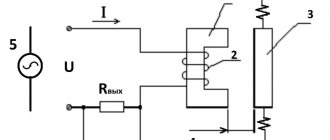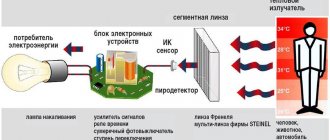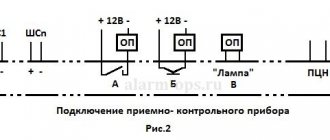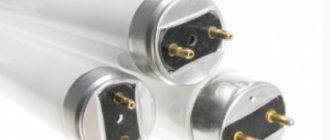Where used, types
Products come in several types - ceiling, wall and for hidden installation. They are also conventionally divided into several types according to the principle of operation (we will discuss this in more detail below).
When choosing, consider the installation location. Sensors are divided into household and street lighting.
In the latter case, materials are used that protect the device from negative natural influences. It can be connected on the stairs or on the street. Household devices are designed for installation inside the house.
Depending on the circumstances, sensors that monitor movement can be connected to a spotlight, lamps, or even an Arduino smart home.
The main device manufacturers are ERA, Evan, TDM, LLT, Orbis, Duwi, Camelion, Brennenstuhl, Elektrostandard, FERON, REV, REXANT, Rubetek and others.
Motion sensor for home
When identifying strangers in the protected territory or object, the sensor transmits a signal about recording movements to the security system control panel.
In addition, touch controllers for home and garden can be used for:
- Connecting additional lighting system devices. The controller will turn on the lights in the house only if someone has entered the protected area. This allows you to significantly reduce energy consumption.
- Work with infrared video cameras, as well as monitoring systems for protected objects.
Characteristics
When purchasing a motion sensor, it is important to consider a number of parameters, which determine the features, connection location, and conditions for use.
Main characteristics when choosing:
- WEIGHT. Modern light sensors weigh from 25 to 240 g.
- Maximum load power. When choosing a product, you need to look at the permissible load. Thus, one sensor can switch devices with power from 60 to 2300 W. Please note that when using more powerful devices, it may be necessary to replace the wiring or install a machine with a higher rated current.
- VOLTAGE. The operating voltage varies in a wide range from 1.5 to 220 Volts. Conventionally, motion sensors are divided into several groups - 1.5 V, from 2.2 to 3.6 V, 220 V, 5 or 9 V.
- MAXIMUM VIEWING ANGLE. Here the range is from 30 to 360 degrees. In the latter case, the device operates along the entire perimeter of the room.
- RANGE. The minimum and maximum distance parameters are 8 and 120 m. Here you need to take into account the object on which lighting is provided. You should not choose sensors with an excessively high parameter, because they can react to the movement of strangers.
- RECOMMENDED INSTALLATION HEIGHT. Here the permissible parameter ranges from 1.2 to 16 m.
- PRESENCE OF LED INDICATOR. Some sensors are equipped with an LED that starts blinking when a signal is present. Other LED display options are also possible.
These are the main characteristics that you need to consider when purchasing. We will discuss the selection criteria in more detail below.
Security sensors
A large federal-level security company, Delta, offers installation and maintenance services for security sensors and security systems for apartments, private houses, office and industrial buildings. Thanks to the use of different types of devices, any object can be reliably protected from unauthorized access. From us you can buy wireless security alarm sensors, as well as outdoor motion sensors.
Delta representative offices are located in 30 cities of Russia, and customer service is provided in 100 cities throughout the country 24/7. The company employs 11 thousand qualified specialists, whose main task is to take care of your safety.
Installation of security alarm sensors
Delta company technicians will install security alarm sensors in just 3 hours. The work is done quickly, efficiently and accurately. When installing security sensors, regardless of the number, there is no need to trench the walls - new renovations and interior design will not be affected. After completion of the work, the client is given a brief briefing - specialists will tell how the security system works and what to do if the alarm goes off.
The principle of operation of wireless sensors for security systems
Sensors for security systems are modern devices based on a GSM module that monitor movement, smoke, humidity, door opening and other parameters. If an incident occurs at the site to which the sensor can react, for example, unauthorized entry or fire, the device is triggered, sending a signal via the GSM module to the central alarm panel.
It makes sense to buy and install security sensors together with a security system to ensure comprehensive security for an apartment, home or office. When it is triggered, the information received on the central panel is instantly processed and an SMS notification is sent to the user’s mobile phone, and the alarm signal is also duplicated to the Delta security service remote control. Thanks to security alarm sensors, a security team arrives at the site within 5-7 minutes after receiving an alarm. All rapid response teams are staffed by 6th grade security guards with appropriate equipment.
Delta monitoring stations simultaneously monitor about 250 thousand objects throughout Russia, and more than 750 security teams are ready to go to the scene at the first alarm signal.
Scheme and principle of operation
There is a large selection of sensors on the market that react to movement and allow you to configure the switching on of lighting on different objects. When purchasing such devices, it is necessary to take into account the presence of several types.
Infrared
The products sense the heat emitted by the human body. The main element is a sensor with a Fresnel lens installed on it, which reacts to the approach of heat and bridges the contact group.
Operating principle:
- the radiation is focused into a narrow beam of light and directed to the sensor;
- the sensor detects the signal, receives it and gives a command to operate.
Such devices are conventionally divided into passive and active. In the first case, the response occurs to a change in temperature conditions, and in the second, the operation occurs in the event of a signal interruption.
Criterias of choice
When purchasing a presence sensor to turn on the light, it is important to consider a number of criteria regarding installation and operation features.
Let's highlight the basic recommendations:
- DECIDE THE PLACE FOR INSTALLATION. For outdoor installation, it is advisable to choose devices with protection from IP 55 and higher (preferably from 65). If the product is mounted under a canopy and protected from water, the IP degree is suitable. If the motion sensor is planned to be installed inside, for example, to turn on lighting in a house, apartment or garage, there are no special requirements for the degree of protection.
- CONSIDER POSSIBLE OBSTACLES (WALLS). The most commonly used sensors are sound or infrared sensors. Microwave products are more suitable for security purposes.
- DECIDE YOUR VIEWING ANGLE. If the entrance to the room where the lighting is being adjusted is possible from several points, it is advisable to choose a sensor with a 360-degree angle and mounted on the ceiling. If there is only one passage, 180 degrees is enough.
- DECIDE ON POWER. Before purchasing a device, consider the consumption of the devices that will be connected to it. Sum up the resulting values and add 10-20% on top for reserve.
- CONSIDER YOUR ACTION RADIUS. For a small room, a minimum parameter of 6-10 meters is sufficient. To work over a large area, it is better to choose sensors with a large radius.
- PLEASE BE AWARE OF THE PRESENCE OF ANIMALS. If there are pets in the apartment or in the yard of the house that can affect the sensor, it is better to take devices with special protection.
- PAY ATTENTION TO THE PRESENCE OF A PHOTO RELAY. This is a big plus, because in this case the product turns on only in the absence of light.
We will pay special attention to the choice of lighting devices:
- When installing the sensor outdoors, use LED spotlights, which can easily withstand temperature changes and place less stress on the wiring.
- In open areas, it is better to use lamps that operate on the luminescent principle.
- When organizing driveway lighting, you can use all types of lamps, but in order to save money, it is better to choose the LED option.
Knowing the features of choosing a motion sensor and lighting elements, it is easier to make the right purchase and not make a mistake with the choice.
Types of sensors
They differ in the element of response. For each circuit, devices are selected that provide maximum recognition and instantly provide a signal. Therefore, more often than not, several types are used in signaling.
- Infrared sensors include three components:
- Optical system that forms the driving element.
- A pyroelectric receiver that captures human heat waves.
- A processing unit that recognizes a moving object against a background of natural noise. Infrared devices are the most popular in modern security alarm systems. Used for monitoring indoors and surrounding areas. When installing, it is necessary to take into account the influence of sunlight on the operation of the device. The operation of infrared devices is completely safe for human health, since in operating condition they do not produce harmful radiation.
- Ultrasonic models are equipped with a sound wave generator that scans objects within range and transmits the signal to the receiver. Any changes between the emitted and received waves trigger the sensing element and send a signal to the control panel. Ultrasonic devices are effectively used in complex environments where blind spots are difficult to monitor, and in the automotive industry. The advantage of devices of this type is resistance to changes in temperature, humidity and other atmospheric influences.
- Microwave sensors are capable of covering a control zone with thin partitions made of wood, glass and even plaster. Emitted electromagnetic waves instantly signal the approach of a conductive object. The high degree of capture is able to respond even to slow movements. The compact dimensions of the devices fit into any interior. However, we should not forget about the dangerous impact of microwave waves on human health. It is better to install devices with low power indoors.
- Combined models combine several response elements in one device, which ensures a high degree of reliability. Sensitivity and microprocessor processing minimize false alarms. More often a combination of microwaves and infrared radiation is used.
How to connect for lighting: on the stairs, in the apartment, on the street
There are five different connection schemes for lighting control. Let's look at the features of each option and common mistakes.
Circuits without a switch
To begin with, let's highlight circuit solutions that do not involve the use of a switch.
Two-wire connection
This is the simplest option, which involves the use of several elements - a 220 V circuit breaker, a sensor, a junction box and a lighting source). The principle of assembling the circuit is the same as when installing a lamp.
First, power is supplied to the indicator, and through it is directed to the lamp. It is better to assemble the chain in an individual circuit, rather than in a general lighting chain.
A simplified diagram is shown below.
Using this method, you can connect motion sensors to turn on the lights on the stairs, in an apartment or other object.
The action algorithm looks like this:
- Place a cable with three cores and a 1.5 square wire into the junction box and label the wires (indicate the phase, ground and neutral wires).
- Stretch two wires to the installation site of the control product, which gives the command to turn on the lighting.
- Place the device at a height of 120-200 cm from the floor. When installing, make sure that it does not interfere with the opening of doors or other mechanisms. It is not recommended to install near heating elements.
- Also place the cable that goes to the light source in the box.
- Connect all the wires using special terminal blocks - phase, neutral and ground.
- Connect the wires to the sensor. Place the phase on the terminal with L, and the second wire (from the lamp) on the load symbol.
- Finish the installation by installing the box and setting it up. Set the automatic mode, operating time interval and sensitivity level.
How to avoid false positives
To avoid false switching on of lighting in the circuit solutions discussed above, follow these tips:
- Do not place sensors near trees or heating devices.
- Always break only the phase.
- Make sure that light rays, for example from an incandescent lamp, do not penetrate to the sensor.
- Attach the product depending on the type (wall, ceiling).
- Do not install the device near air conditioners or windows where there is air movement.
- Make sure that the glass of the infrared product is clean and undamaged.
Following the above tips allows you to quickly and without errors connect a device to control lighting on the stairs, in an apartment or on the street.
How to connect to a spotlight
Another issue that requires consideration is how to properly connect a motion sensor to a floodlight.
To do this, you can use one of the following schemes:
- WITH THREE CONTACTS. In this case, the phase is supplied from the shield to terminal L. From output A, the wire goes to the input L of the spotlight. Voltage is supplied when the motion sensor is triggered. Contacts N are combined and directed to the shield. The ground is sent directly to the spotlight and connected to the PE to remove possible voltage from the metal housing.
- USING A SINGLE KEY SWITCH. In the solution discussed above, the use of a switch is not provided. But this can be fixed. As a rule, the switch is mounted in a phase break (before the product that controls the movement). In this case, when the switch is turned off, the voltage is removed from the entire circuit. The second option for connecting the switch is parallel to the phase and the output of the motion sensor. With this solution, you can turn on the lighting without being tied to other devices. When the switch is turned off, the entire circuit operates as usual.
- USING A TWO-KEY SWITCH. In this case, a certain symbiosis of the two circuit solutions discussed above is introduced. One contact of the switch breaks the phase, and the second comes in parallel. When both buttons are disconnected, the voltage is completely removed from the circuit. When the first key is turned off, the sensor operates in normal mode and turns on the spotlight when movement occurs. If only the second key is activated, voltage is immediately applied to the lamp.
- TWO SENSORS. The same principle applies here as discussed above. Two movement-controlling organs are arranged in parallel, after which they are connected to the power circuit and the spotlight.
- CONNECTING THE LAMP TO A LOWER VOLTAGE. If it is necessary to turn on the spotlight at a lower voltage (12, 24 or 36), a power supply is installed in front of the input, reducing 220 V to the required level. In this case, three wires (with ground) are supplied to the power supply input; only power is sent to the sensor.
- FOR A SEPARATE PHOTO RELAY. When installing old motion controllers without a photo relay, the latter must be connected separately. In this case, the wire goes from the output of the sensor to the relay, and after that to the input of the spotlight. The zeros are combined and the ground goes towards the light source.
Above are the basic diagrams that allow you to connect a spotlight with or without a switch. Here everyone makes a decision taking into account the current tasks and characteristics of the room.
How to connect to Arduino
Of no less interest is connecting a motion sensor to Arduino to organize a smart home.
To solve the problem you need to prepare:
- Arduino board;
- PIR motion control device;
- solderless breadboard;
- 220 Ohm resistance and LED;
- wires of the male-male and male-male types.
The name of the contact connections may differ from one manufacturer to another, so before performing work it is necessary to study the features of the module.
One pin is connected to GND, the next to VCC (5 V), and the remaining one to OUT (transmits a digital signal from the PIR sensor).
PIR sensors are almost identical in design. They have the necessary sensitivity at a distance of up to six meters, and visibility is 110*70 degrees. The output appears 0 or 1 depending on whether the fact of movement is detected.
Ultrasonic sensors
This type of motion sensor constantly distributes ultrasound around itself. If there is a sudden movement in the propagation zone, the device is triggered and closes the lighting circuit.
The disadvantage of ultrasound is the discomfort of pets, which, unlike people, feel ultrasound. Also, ultrasonic sensors will not work if a person moves very smoothly; sudden movements are required to trigger.
The advantages of ultrasonic sensors include low price, all-weather operation, operation on any type of human clothing.
Articles on the topic: electronic ballasts and electronic ballasts. What are the differences between ballasts
Can I do it myself?
Despite the low price of sensors, many people try to make the devices themselves and save money. The advantages of such a solution are the ability to thoroughly understand the principle of operation, reduce maintenance costs and “tailor” the device to specific application conditions.
In addition, with proper assembly, you can reduce costs and even upgrade the system.
But there are also disadvantages. Before you start work, you need to purchase equipment, draw a diagram, decide on dimensions and other points. This requires experience and knowledge. However, there is no guarantee that the finished scheme will work.
If you decide to assemble the motion sensor yourself, prepare the following items:
- circuit assembly housing;
- set of elements;
- soldering iron and wires of different sections;
- fastening;
- screwdriver;
- other materials - electrical tape, pliers, cambric.
To turn on the lighting, a sensor with a photocell built into it will be used. A photo relay will act as a switch.
To collect the diagram you will need:
- capacitor (C1);
- operational amplifier DA1;
- phototransistor (VT1);
- resistance R1 to load the collector and create an operating point;
- resistor R2 to implement feedback.
When assembled correctly, the circuit works like this. After light enters VT1, the element is triggered and the phototransistor opens, followed by charging C1. When the voltage is removed from VT1, the capacitor discharges and the voltage decreases.
The light source for the photocell can be a simple laser or an infrared LED.
The assembly proceeds according to the following algorithm:
- Assemble the power supply, adjust it and monitor the current output.
- Connect a resistor to the negative of the power source.
- Connect the diode using the cathode.
- Connect a tuning resistor to the anode.
- Connect the transistor emitter to the negative wire of the power supply.
- Connect the resistor to the base circuit.
After assembly, all that remains is to test the correct operation of the product when light hits it. Possible errors must be eliminated immediately upon detection.
Types of sensors
Motion sensors differ in design, data transmission method and operating principle. As for the design, they can be modular or monoblock. Devices of the first type are a housing base into which individual sensitive elements can be integrated. This is convenient from an installation point of view: once you install the housing unit at the operating point, you don’t have to think about changing the direction of the sensors in the future. It is enough to replace the sensitive segment and the system will be completely reoriented.
Monoblock devices are small in size and can be installed once without the possibility of replacing the sensitive filling. Based on the method of data transmission, we can distinguish between a wireless motion sensor for alarms and traditional models that connect via cable. Wireless detectors are more popular because they require minimal installation effort and are seamlessly integrated into almost all modern security systems.
Wired models have the advantage of reliable power supply and communication stability - they cannot be damaged by third-party radio signal jammers, for example. But at the same time, cable wiring not only requires extensive installation work, but also, in the absence of proper camouflage, can reveal itself to an intruder. Based on the principle of operation, ultrasonic, infrared and electromagnetic sensors can be distinguished. They are worth considering separately.
Possible problems
Other reasons may also lead to false alarms and incorrect operation of the sensor, which we mentioned above:
- Installing a wall sensor on the ceiling. If such an error was made, the device will not work correctly because the viewing angles are different.
- Random activation of the sensor after it has been turned off. This often happens with IR products when there is a light source next to the device, the beam from which directly hits the sensitive element. Therefore, it is important to place it away from lighting fixtures.
- The influence of drafts, wind and glare. The sensor cannot be mounted on air conditioners, above windows, or in corridors where there is a strong draft. Above places where water accumulates and where direct sunlight falls. Reflected glare hitting the sensitive element of the sensor will lead to its frequent operation.











